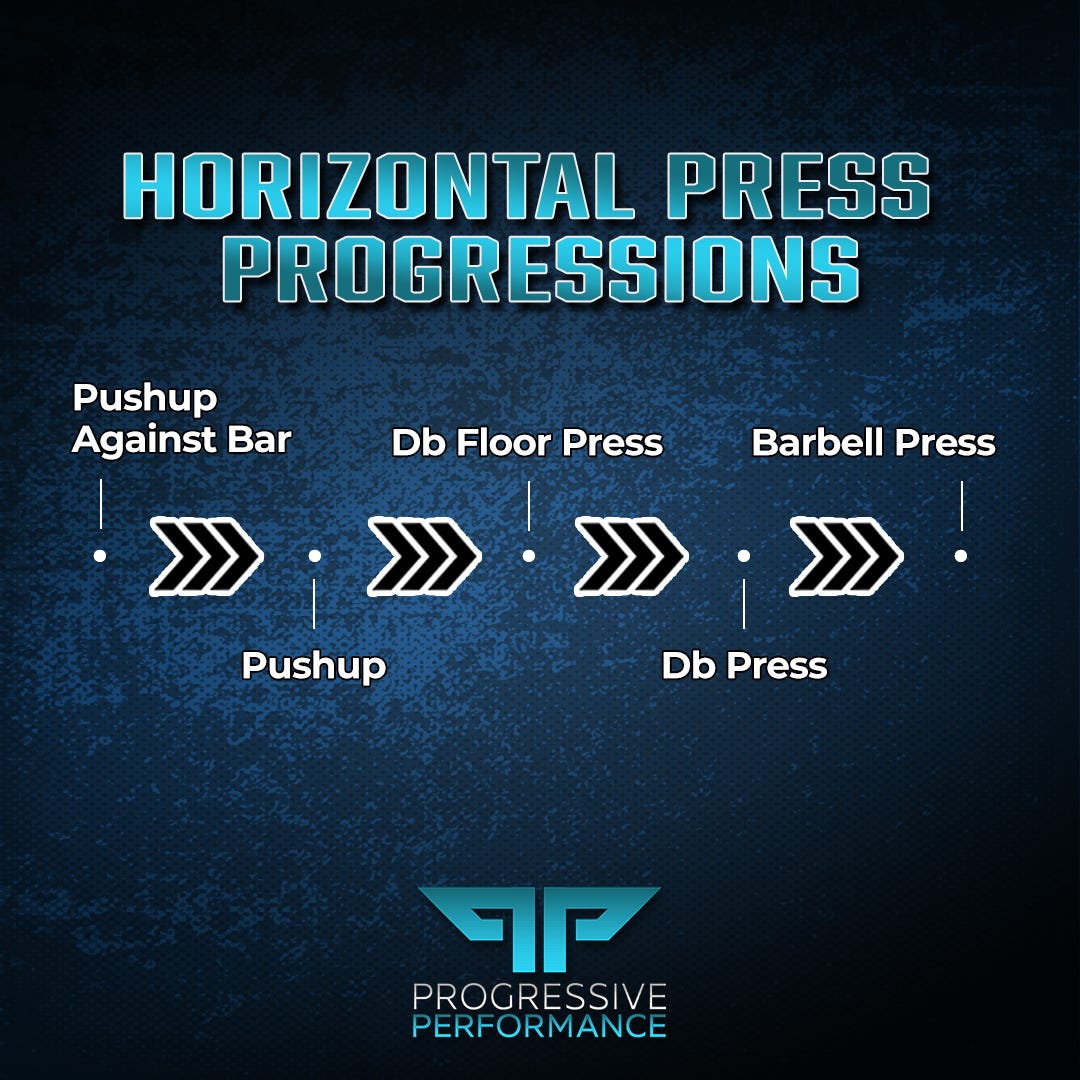
Sticking with the primal vibes…pushing things away is an innate, evolutionary action that doesn’t need to be explicitly taught. Whether it’s pushing the ground away to stand up, or pushing away repulsive food, we’ve been conditioned to this pattern since infancy.
How do we take something that we do so naturally and progress it into gains?
Push-Up Against Bar
Outside of cheating and using a specifically designed machine, push-ups performed against an elevated bar is the lowest level of the Horizontal Press pattern. (Note: Push-Ups From Knees are also a regressed form of the traditional push-up, but use of the elevated bar tends to create better outcomes)
The ability to easily adjust the difficulty by changing the height of the bar makes this variation a great option for anyone attempting to hone the basics of the Horizontal Press (i.e. body control, elbow path, core stability, pec/triceps strength, etc).
Push-Up
The natural (and obvious) first progression transfers the trainee’s bodyweight into the Horizontal Press at ground level. Beyond the increase in prerequisite strength, performing Push-Ups with hands and feet at equal-height forces the entire body to generate much more stability and rigidity just to maintain proper positioning. In this sense, Push-Ups are great for solidifying pressing technique but also for teaching the body to work in sync.
As a final feather in the cap, closed-chain movements (like Push-Up variations) allow for unrestrained scapular movement, which is especially key for novice/beginner trainees to get comfortable with as they ascend the ladder of complexity and advancement.
DB Floor Press
When one has mastered the technical aspects of the Push-Up and bodyweight is no longer overloading, open-chain movements can provide a novel stimulus and challenge — the most nascent in this category being the DB Floor Press. This variation only employs the top half of the ROM (from ~90º elbow flexion to lockout), thereby avoiding the strain/risk of a fully-loaded lengthened position and allowing previously-honed skills (e.g. pec strength, shoulder/lat stability, etc) to be further tested with the increased instability inherent with DBs.
DB Press
Mechanically similar to the DB Floor Press, this variation extends the required skill set to include the full active ROM. DB Presses — specifically FLAT DB Presses — allow more mechanical tension to be created at the muscular-level, but also leave much less room for technical error on the part of the trainee.
In addition to the challenges that come with greater ROMs, DB Presses demand another skill-set be developed, one that is unrelated to the actual skill-set of Horizontal Pressing: learning how to get the DBs into position. Even if everything else is perfect, an inefficient kick-back, initial rep or dismount can tank the overall effectiveness of the movement while skyrocketing risk of injury.
Barbell Bench Press
Pulling it all together, we conclude with the Barbell Bench Press. Don’t get it twisted, there are more complex Horizontal Press variations out there, but this monument of bro-ness represents the culmination of disparate skills — pec/triceps/delt strength, shoulder/scapular stability, technical soundness, and full-body synchronization — to create the most-balanced environment for absolute load, hypertrophic potential, and power development.
The perfect Barbell Bench Press is are a rare sight to see, but is well-worth the pursuit.
It’s important to note that the progression provided here is just an example of how one can traverse the Horizontal Press pattern. There are many ways to skin this cat, and one must consider many variables — each individual will have varying anatomy, strength, peripheral control, and injury history.
Many variations that can be viable nodes within this spectrum also come with unique demands, as we’ve seen with the differences between open-versus-closed-chain movements (to name a single variable). Note that there are simple work-arounds for just about all of these.
For example, if maintaining positioning in a Push-Up is an issue due to a lack of core stability relative to bodyweight, a Machine Chest Press might actually be the better intermediate option — and that’s just one of an infinite number of options for modifying according to one’s strengths and weaknesses.
Progression through the Horizontal Press pattern — regardless of limitations — is very possible. The key is to identify the hang-up (i.e. shoulder stability, pec strength, coordination, etc) and program in a way that suppresses the problem’s effect or alleviates it completely by turning the weakness into a strength.
